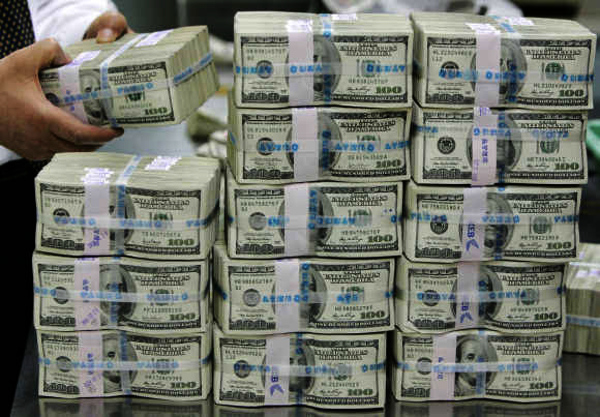Riding on the increased flow of funds by foreign portfolio investors (FPIs) and rise in foreign direct investment (FDI), foreign exchange reserves continued their surge for the 11th straight week, rising by $2.3 billion in the week ended December 6, 2019 to hit an all-time high of $453.4 billion.
According to the weekly forex data released by the Reserve Bank of India, while the forex reserves have grown by $24.8 billion over the last 11 weeks since the Finance Minister announced a cut in the corporate tax rate on September 20, it has jumped by $60 billion in the current calendar year.
The continued inflow of funds by foreign investors despite a slowdown in economic growth has fuelled the rise in forex reserves. While the FDI in the first half of the current financial year amounted to $35 billion (as per data provided by the government on Friday), the FPIs have pumped in a net of $10.7 billion into the Indian equity and debt markets in the current financial year till date. In the current financial year the forex reserves have jumped by over $41 billion.
EXPLAINED: Govt’s Steps Help Bring in FPIs, FDI
Despite the slowdown in economic growth, strong inflow of FPI and FDI money has pushed forex reserves by over $41 billion in the current financial year. While FPI inflow since April 1 has amounted to $10.7 billion, FDI in H1 stood at $35 billion. The pace of inflow of funds accelerated since the government announced cut in corporate tax rates in September.
In the reporting week ended December 6, the rise in reserves was mainly on account of an increase in foreign currency assets, a major component of the overall reserves, which surged by $1.891 billion to $421.258 billion. During the week, the gold reserves also increased by $430 million to $27.08 billion.
Experts say that the government’s decision to reverse its Budget decision relating to higher surcharge impact on FPIs along with a cut in the corporate tax rate last month has played a significant role in turning the investors mood and draw them to invest in the Indian economy and markets.
Between September and now, the FPIs have invested a net of Rs 43,435 crore (over $6 billion) into Indian equity and debt market. By contrast, they pulled out a net of Rs 8,874 crore between July and August 2019 (aggregate of debt and equity markets).
On the other hand, a stability in global crude oil prices (between $60 and $65 per barrel) and currency (between 70-72 to a USD) have also benefitted as it keeps the import bill stable. The inflow of funds has also been affected by US Federal Reserve’s decision to cut interest rates in the US.
The rise in forex reserves alongside a softening of crude oil prices also comes as a breather for the country’s rising external debt which has risen significantly over last couple of years from $485 billion in June 2017 to $557 billion in June 2019. Experts say that if external debts are higher than the forex reserves, it makes the economy vulnerable to any oil price shocks. However, as of now there is some relief on that account as forex reserves are also climbing and the crude oil prices continue to remain stable.
A rise in forex reserves will help improve the ratio of foreign exchange to external debt which has deteriorated from a high of 106 per cent in June 2010 to 76.7 per cent in June 2019. Assuming that the external debt stands at $557 billion, then at the current forex reserves the ratio of forex to external debt would have improved to 81.3 per cent from 76.7 per cent in June.
Source: IE
Image Courtesy: Rediff
You may also like
-
Trade Connect E-platform For Exports Is Single Window, Fast, Accessible And Transformational: Shri Piyush Goyal
-
Dot Simplifies Approval Processes For Telecom Licenses And Wireless Equipment
-
Coal Production and Supply Trends on Positive Trajectory
-
Union Minister To Release Booklets On Promotion Of Indigenous Species & Conservation Of States Fishes
-
2nd India-Japan Finance Dialogue held in Tokyo on 6th September, 2024
